Homemade apple jelly is a delicious preserve, a beautiful tasting, sweet clear jelly that is simple to make. Great spread on hot toast or fresh baked scones.
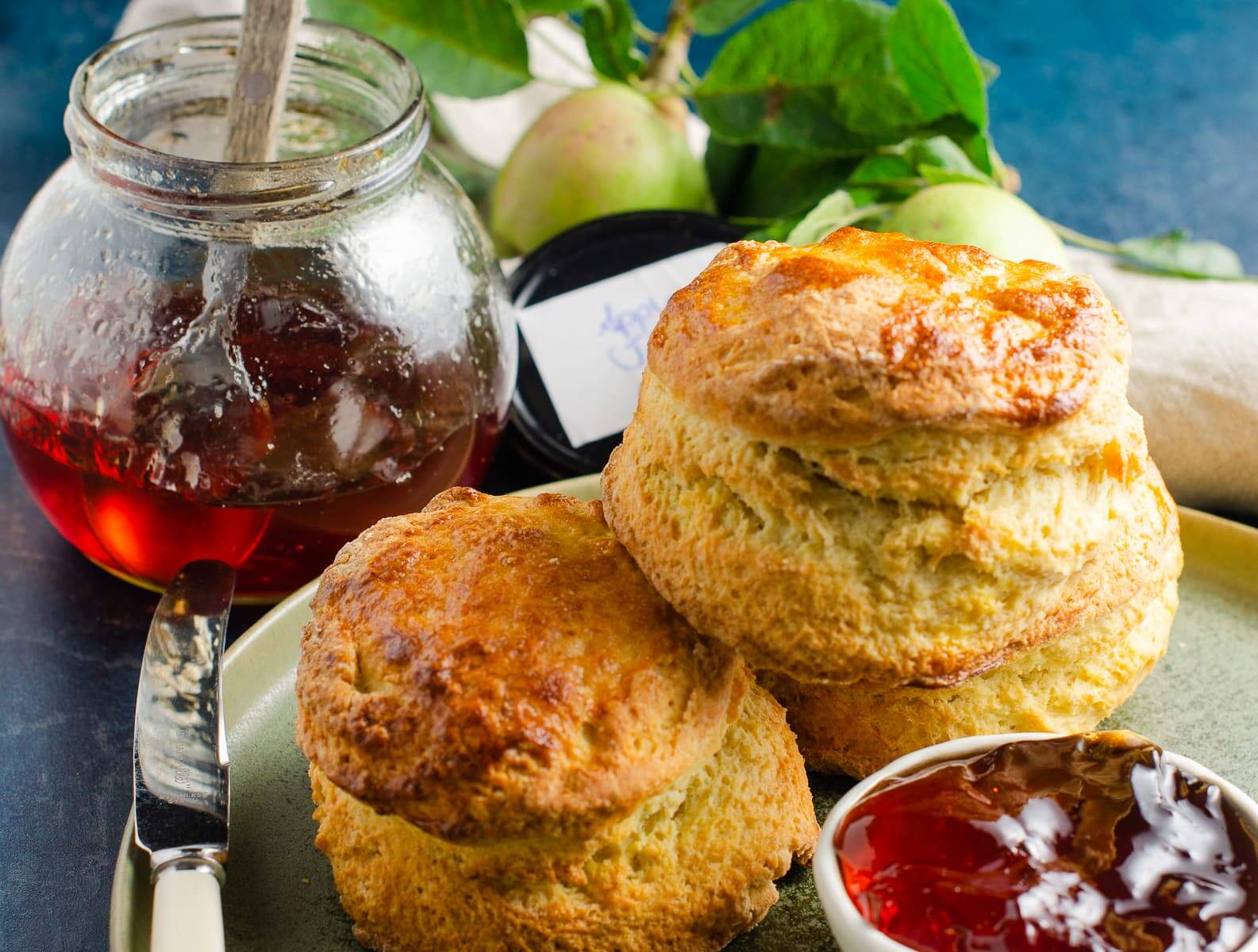
Apple jelly is a delight to eat and something I look forward to making every year during Autumn. I grew up with parents who were very self sufficient when it came to putting fresh garden produce on the table.
We ate very well over the summer months and what could not be eaten was either stored over winter in our garage or frozen straight from picking. The garden was large and had a multitude of fruit trees and shrubs, from which my Mum would produce the most wonderful array of jams and jelly's.
Until last year Michelle only ever bought strawberry jam. I gave her a pot of homemade apple and raspberry jelly, earning myself the title of Jelly Lady, as her girls now come to me direct for supplies when the pot is empty.

Setting up the equipment to make jelly:
Key to the success of any jam or jelly making is time. This is not a job to start when you've other things to do. Any experienced jam maker will tell you that once you start you give yourself time to just concentrated on the jam! Take your eye off the ball and it won't end well!
Get all your equipment looked out and set up before you start. Ensure you have everything to hand and jam jars with tight sealing lids!
How to make Apple Jelly - Recipe steps:
Making the apple juice:

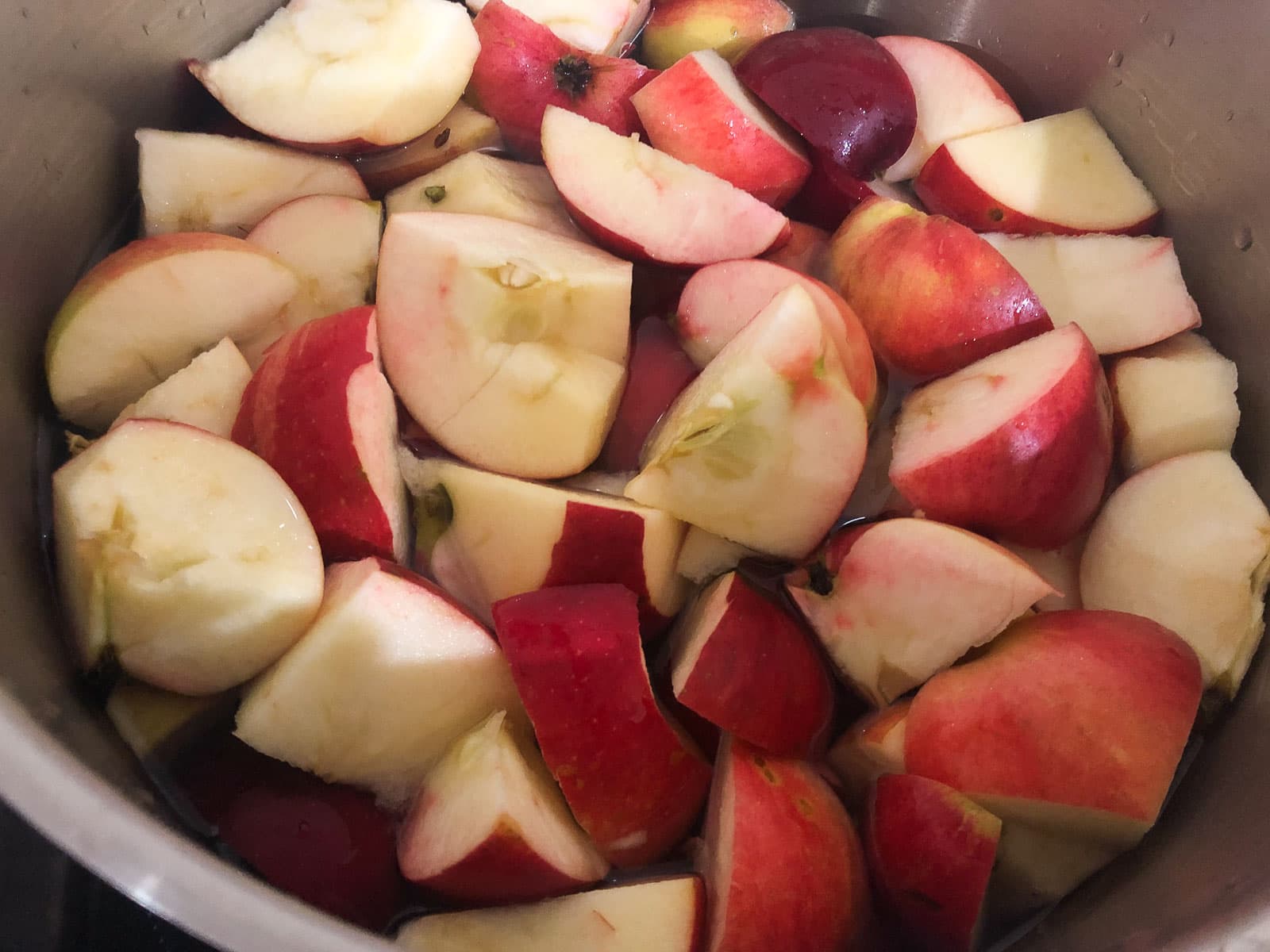
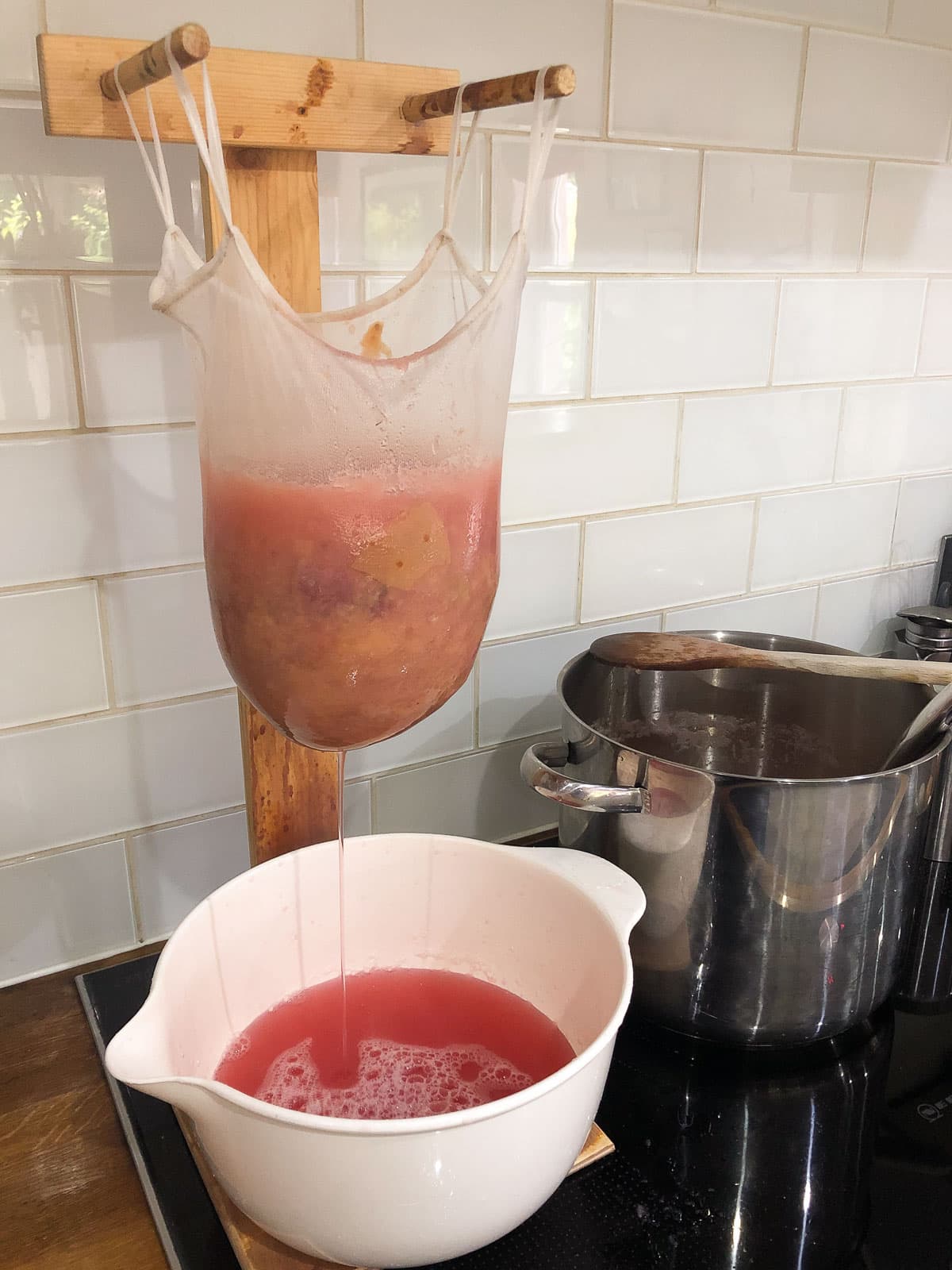
Making the apple jelly:
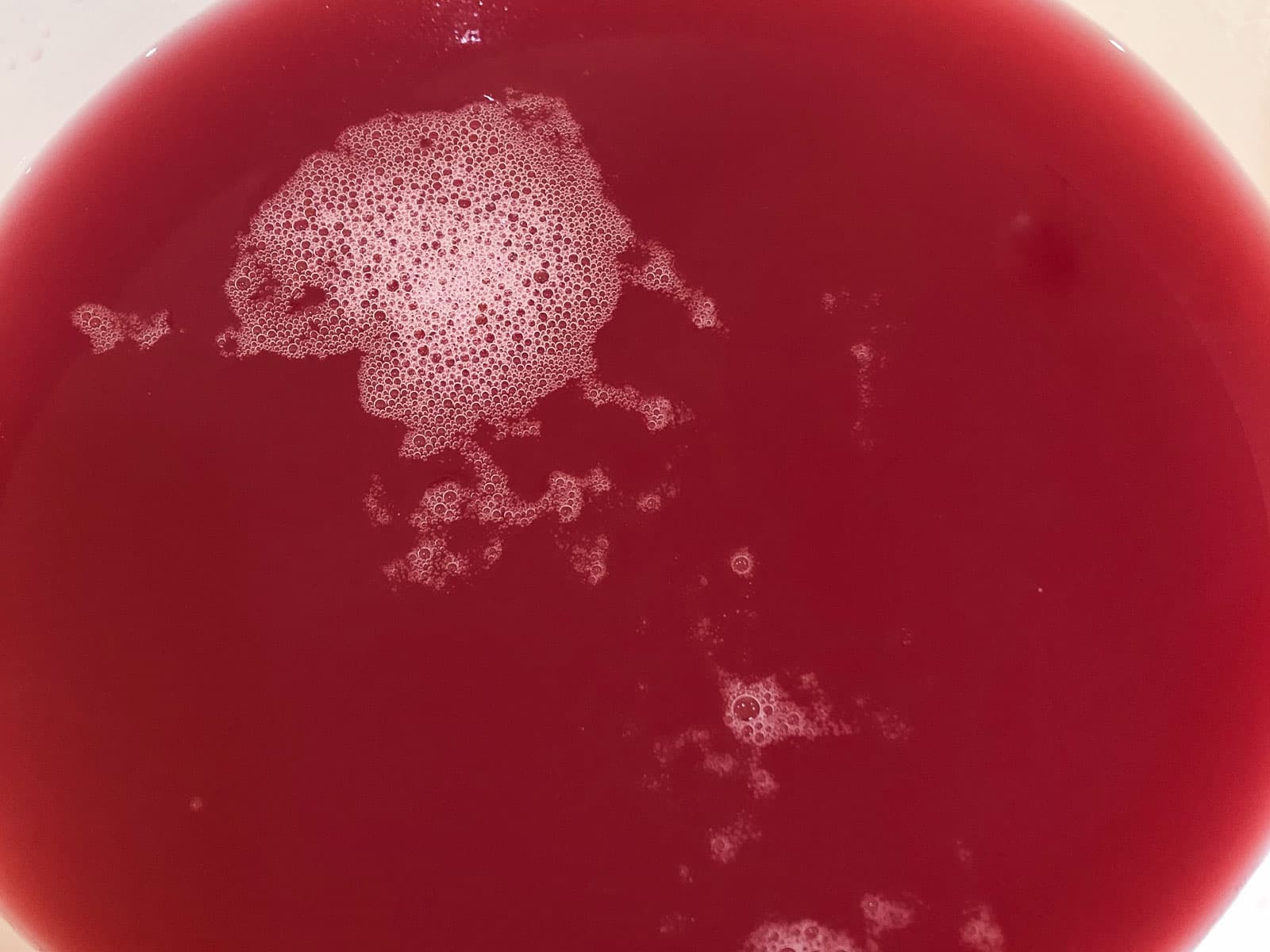
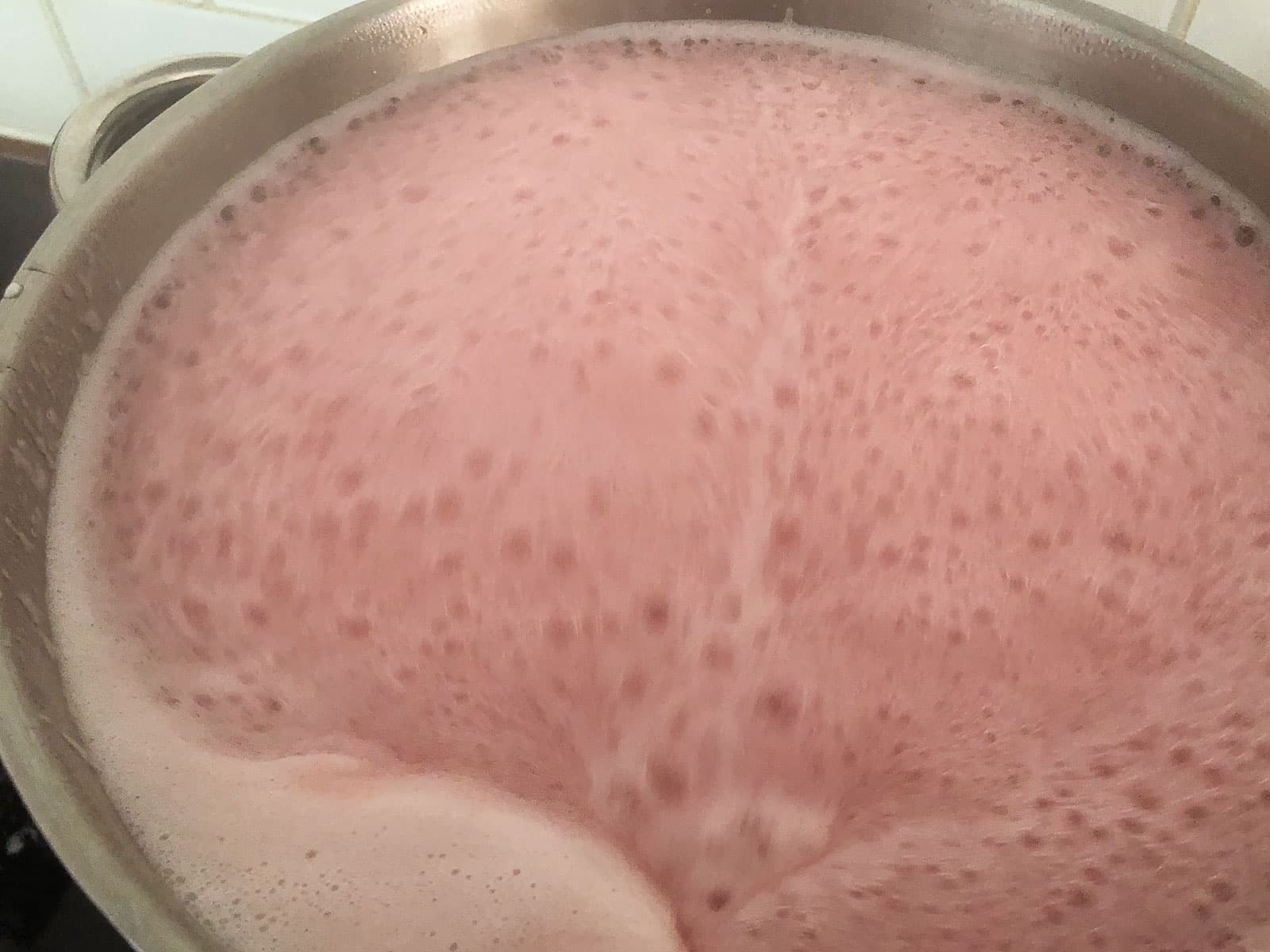
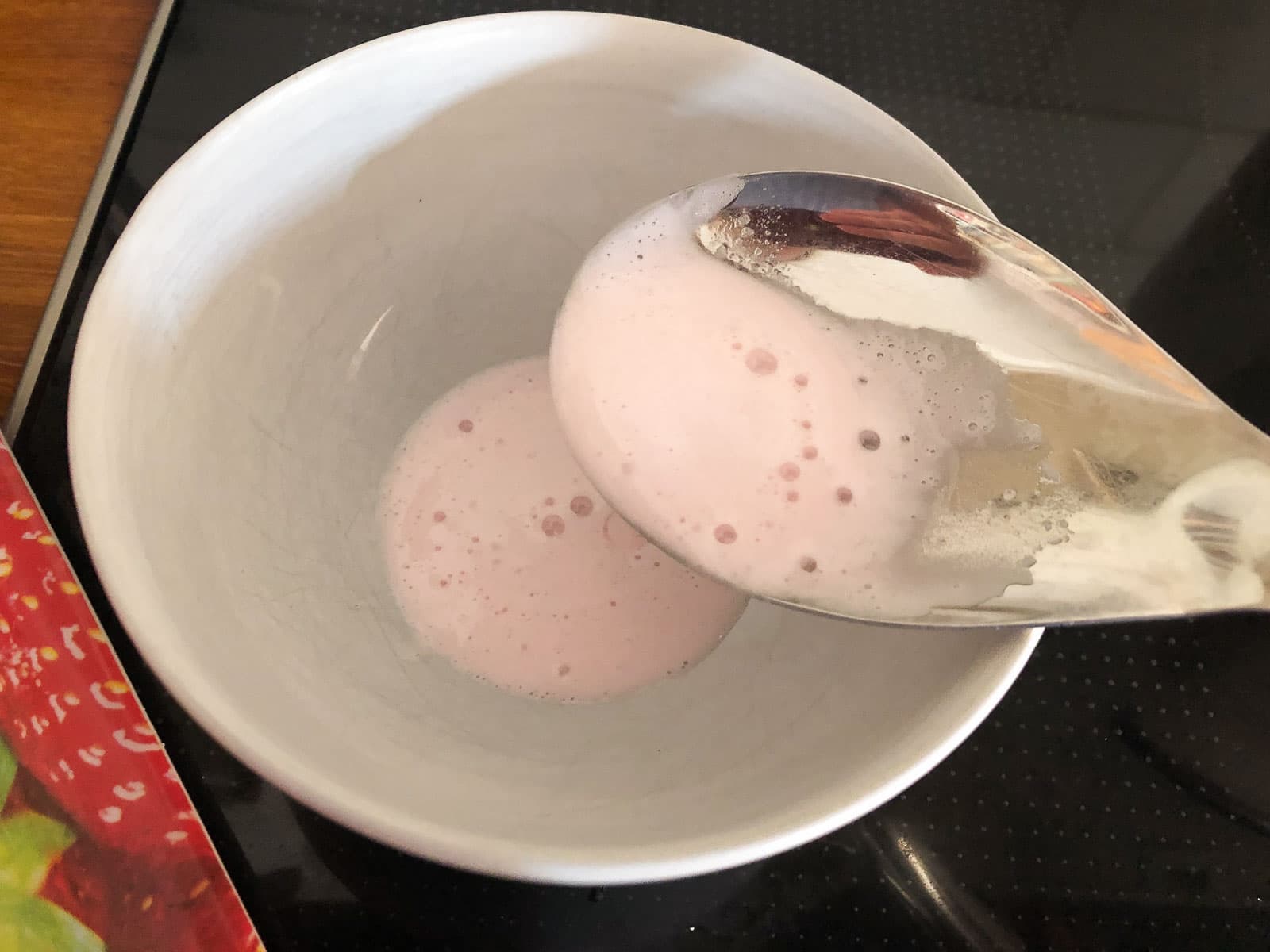
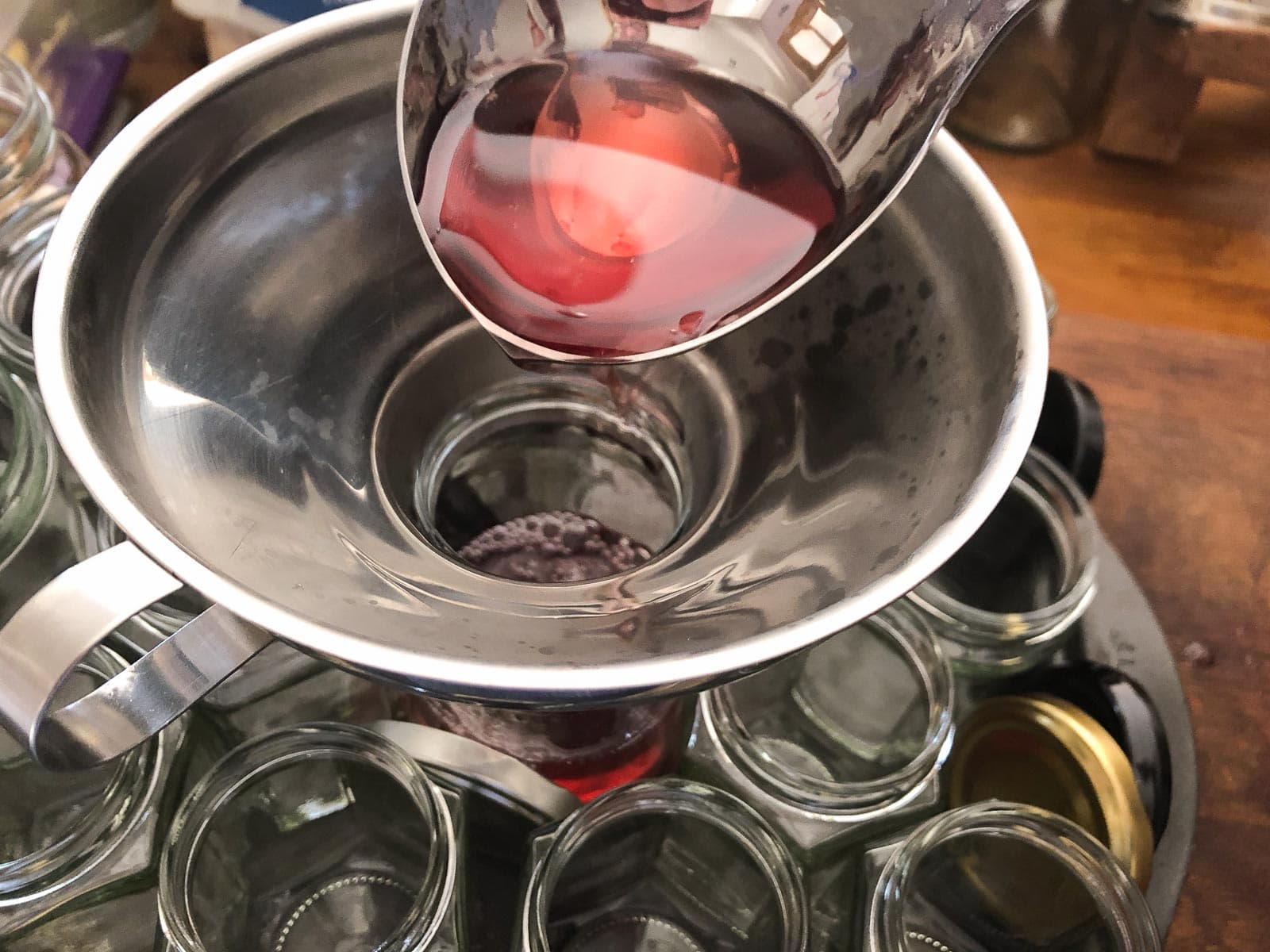
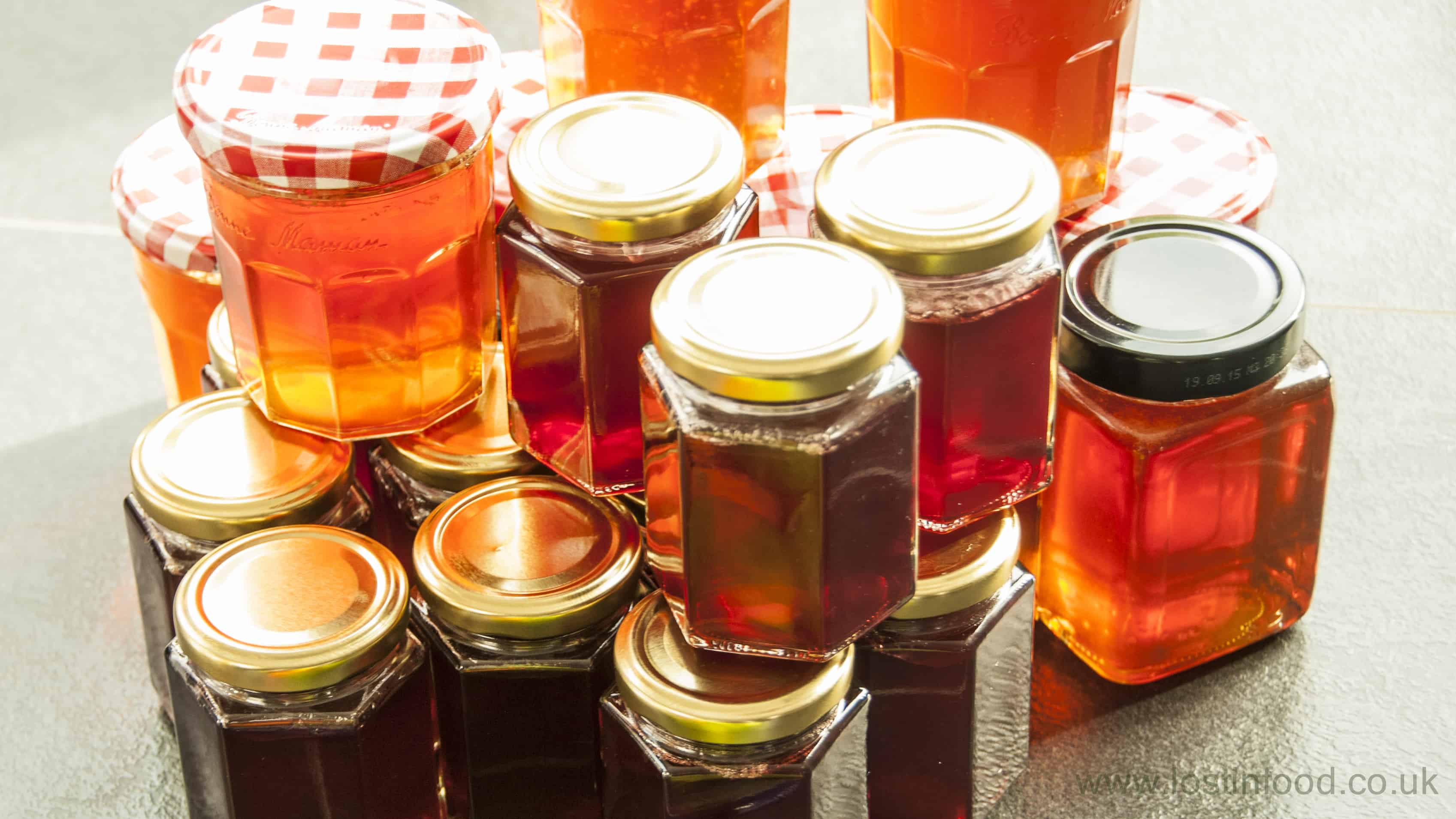
How to prepare the apples?
Seedless apple jam or jelly is easy to make, however there are a few key points. First simply wash and cut up the fruit. There is no need to peel or core the apples, just remove any rotten bits.
Its worth mentioning at this point that you can also make crab apple jelly using exactly the same process. Crab apple jelly is delicious, the sugar balancing out the more sour fruits.
Then place them in a large stock pot or jam pan. Pour in cold water which should come just below the top line of the fruit.
Simmer away gently until the apples are soft, this will take between 30-45 minutes. Take the apples off the heat and spoon the apples and liquid into the jelly bag, catching the strained liquid in a clean bowl set below the bag.
Jam sugar:
Sugar is used to preserve the fruit, it is what allows you to keep and store jam. Traditionally jam making uses equal amounts of sugar to fruit, or in the case of a jelly a pint of fruit juice to a pound of sugar. The amount of sugar used determines the set of the jam. I have always used granulated sugar when making jellies and jams. Granulated sugar is cheaper and melts quickly.
Some fruits like apples, blackberries and blackcurrants are naturally high in pectin, meaning that the jam will set easily. (However, if making something like Scottish raspberry jam, you will need to add in pectin and this is done by adding a little lemon juice to the raspberries and the sugar.)
You can buy jam sugar which has added pectin, however in my experience it can result in too firm a set. For this reason I prefer to use granulated sugar and if necessary add a little lemon juice. It is also a lot cheaper.
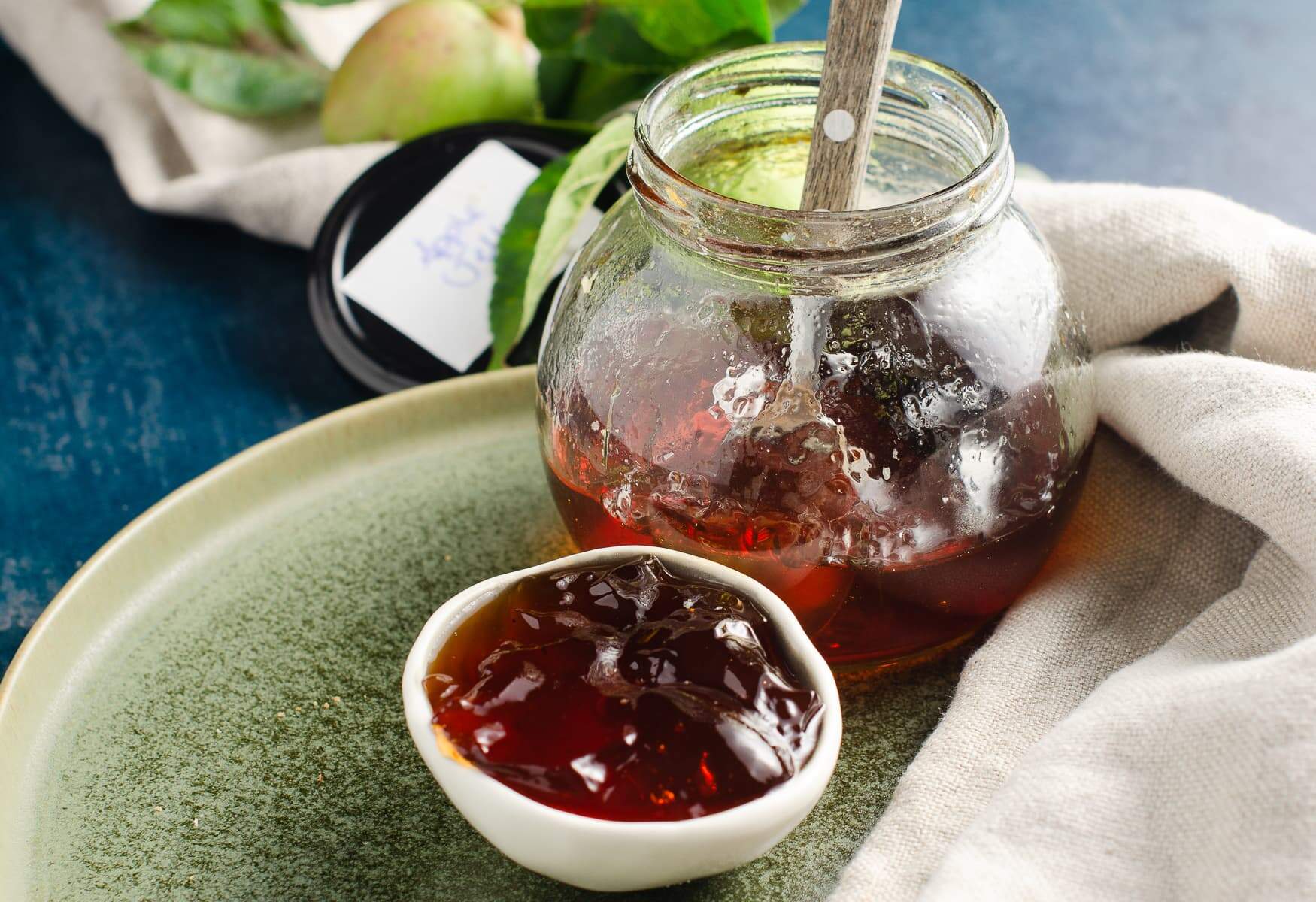
How to achieve a clear jelly?
Top tip when straining apple juice:
When straining the apples DO NOT push down on the fruit as this will result in a cloudy jelly. Simply allow the weight of the fruit to drain the juice through the jelly bag.
Top tip when boiling jelly:
Next when making the jelly you are required to boil it. Some scum will rise to the top when doing this, so use a long handled spoon to skim off any scum. Whilst it will do not harm if eaten, it makes a very cloudy jelly.
Testing the set of jam or jelly?
Knowing when jam and jelly is ready to take off the heat and testing the set of jam is the trickiest part of the whole process. One that you get better at as you become more experienced.
I always use a jam thermometer. It really is the only way to check your jelly or jam has reached the required setting temperature. The setting point for jam is 104.5C/220F.
I like to use the wrinkle test. Place a plate in the freezer before you started making jam or jelly, take it out when you think the jam or jelly is almost ready.
Spoon some jam/jelly onto the cold plate, pop it back in the freezer for a minute or two, then take it back out and push the jam with your finger to see if it wrinkles. If it does then it's ready. For a firm set the wrinkle will hold in place. For a softer set the jam/jelly will just wrinkle.
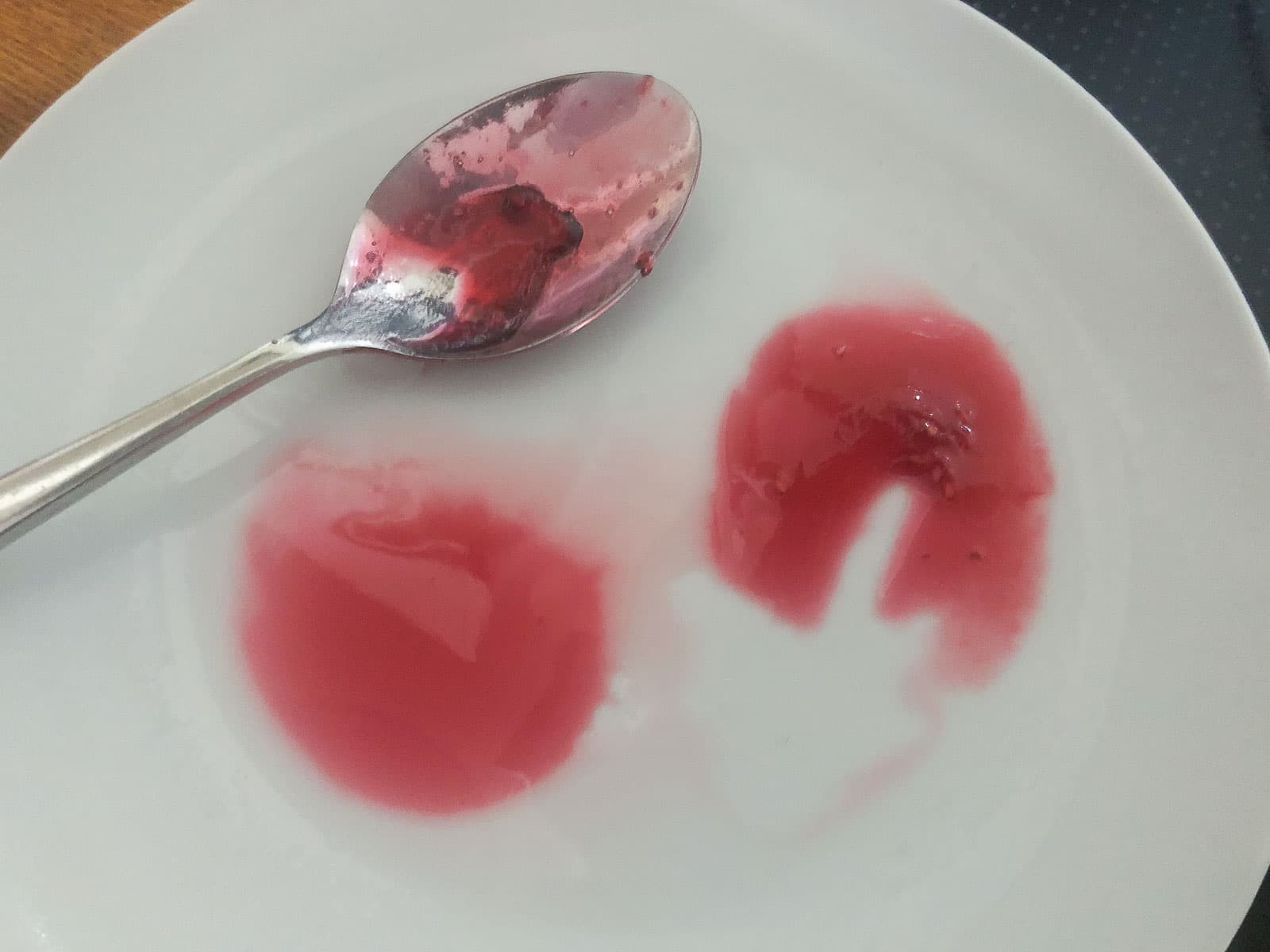
How to sterilise jars?
It is essential that before jarring or bottling any food for storage, that you sterilise the glass jar or bottle first. There are many methods for doing this, all of them relatively straight-forward:
- Firstly, you can wash the glass and lids in hot soapy water, rinse them (do not towel dry) and place on a tray in the oven at 160C for 15 minutes, removing when you are ready to fill. This is my preferred method.
- You can put them through a dishwasher cycle, removing them from the dishwasher as soon as the cycle has finished and filling them with jam immediately afterwards. I use this method if my dishwasher happens to be going on.
- You can boil the jars and lids in a large pan for 10-15 minutes. [I'm never keen on this method as it involves boiling water and leads to a risk of scalding.]
- Finally, you can wash and rinse the glass jars, placing them into the microwave wet and then cooking them on high for 60 seconds. However, the lids would have to be boiled in a pan of water separately for 10-15 minutes as metal cannot go in the microwave. [I have never used this method as it involves 2 separate processes which I think is a bit of a faff!]
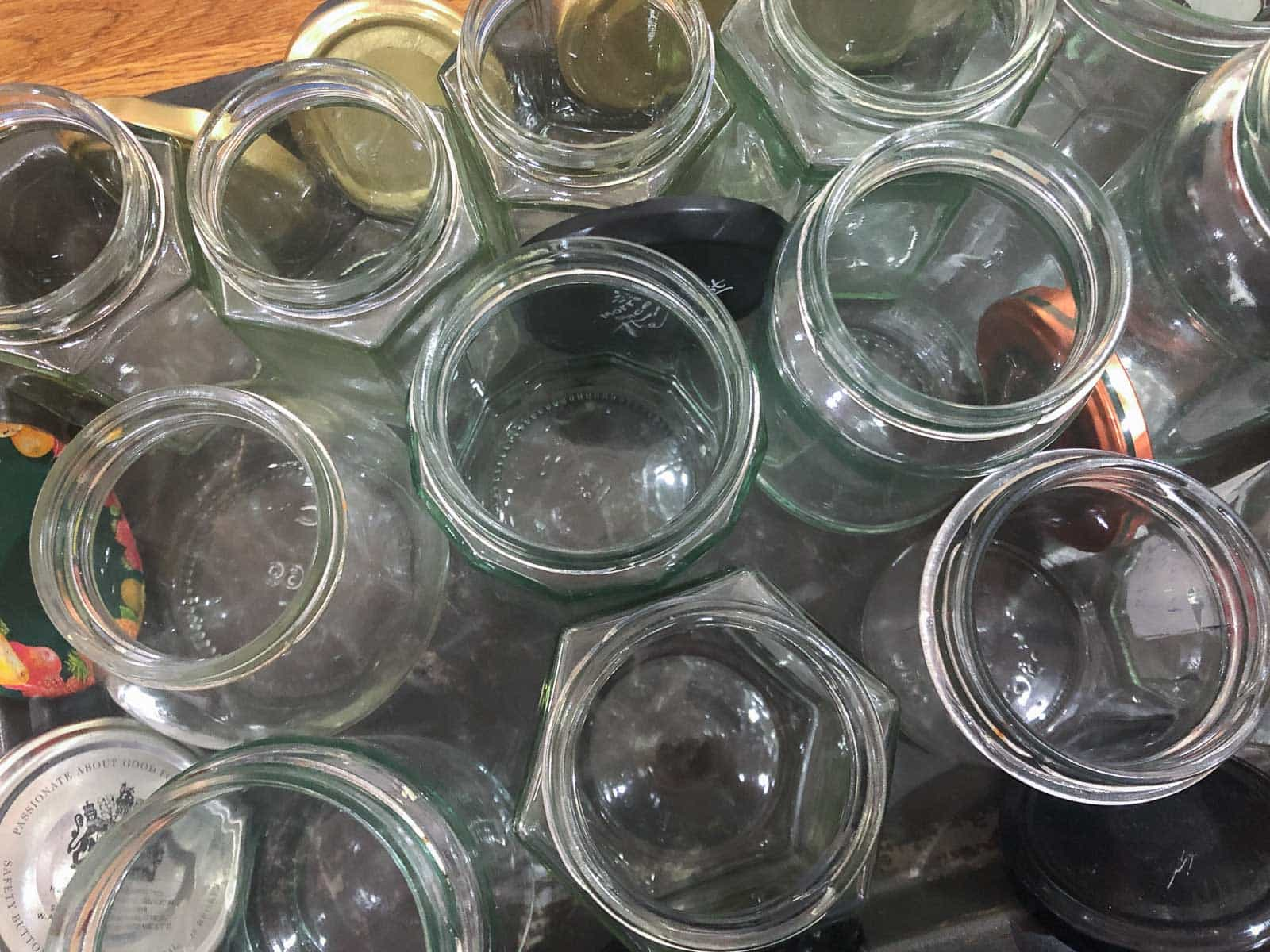
Filling the jam jars:
Finally take real care when decanting the molten jelly liquid into jars. You do not want to burn yourself, nor spill this liquid. I like to keep my jars in a metal baking tray with sides, that way if I do spill a little it doesn't run everywhere.
I also recommend using a jam funnel. The funnel is placed on top of the empty jam jar. It has a wide lip which then funnels the hot liquid down into the jar.
Place a wax jam disc over the top of the jam/jelly, this keeps the jam fresh and keeps air from spoiling it. Seal with a tight fitting lid and set aside to cool before labeling.
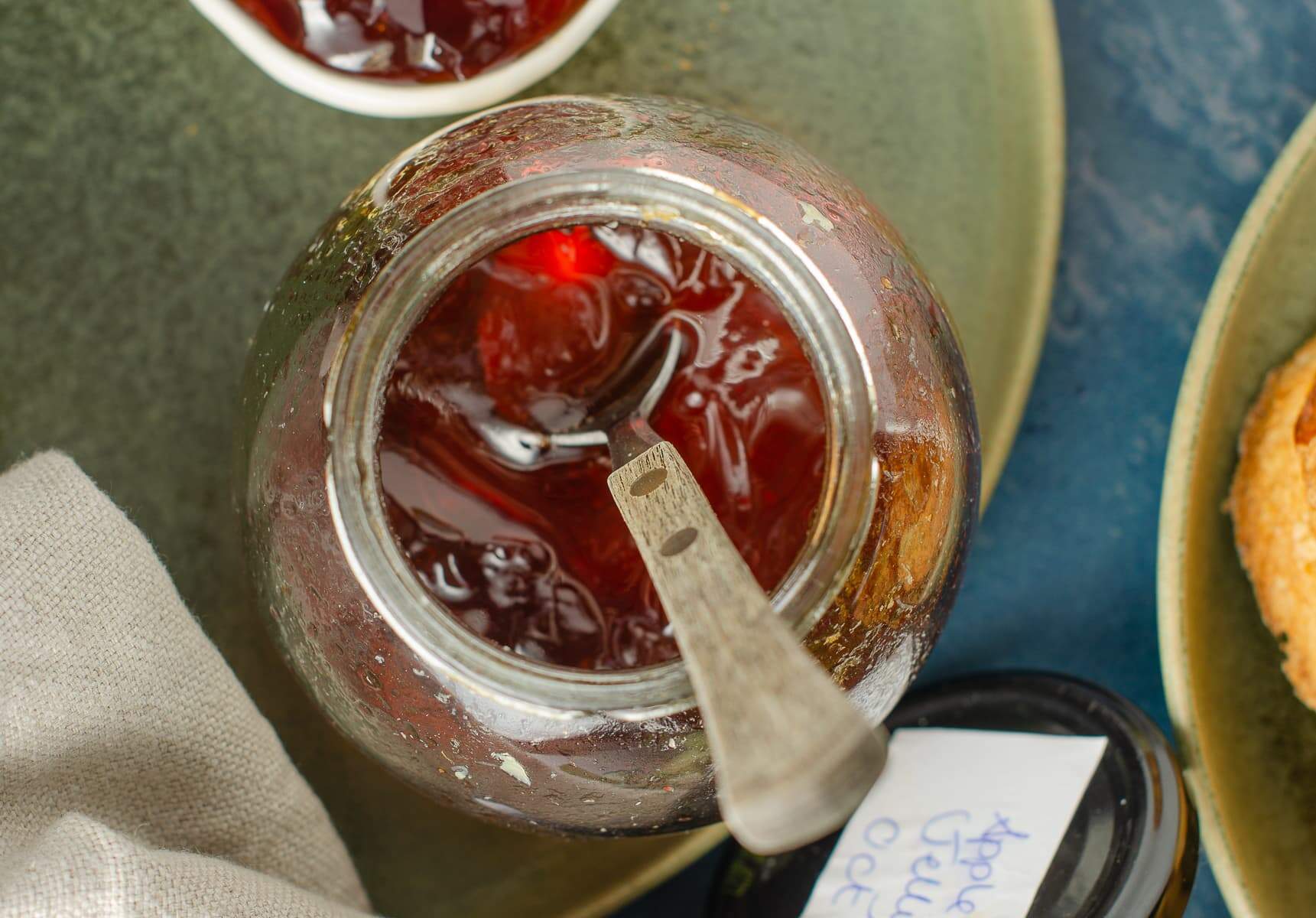
Other flavours to add to apple?
Fruit flavours:
Apple jelly is really nice on it's own but also great when mixed with other flavours, for example blackberry and apple jelly or raspberry and apple jelly. A favourite of mine is to blend apples with wild brambles, a real taste of Autumn.
Apples are naturally high in pectin so are great to help set soft fruits which are naturally lower in pectin. If making a mixed fruit jelly, for example apple and raspberry, cook and strain the two fruits separately then add the juices together when ready to make the jelly.
Soft fruit does not need cutting up before adding to the pan, boil it whole before straining through the jelly bag.
Herbs:
Don't just look at blending apple jelly with other fruits, it also works realy well with herbs. Thyme, rosemary and sage all work really well when blended with apples. Simply add 3 sprigs of the herbs of your choice to the apples when cooking them to form the juice base.
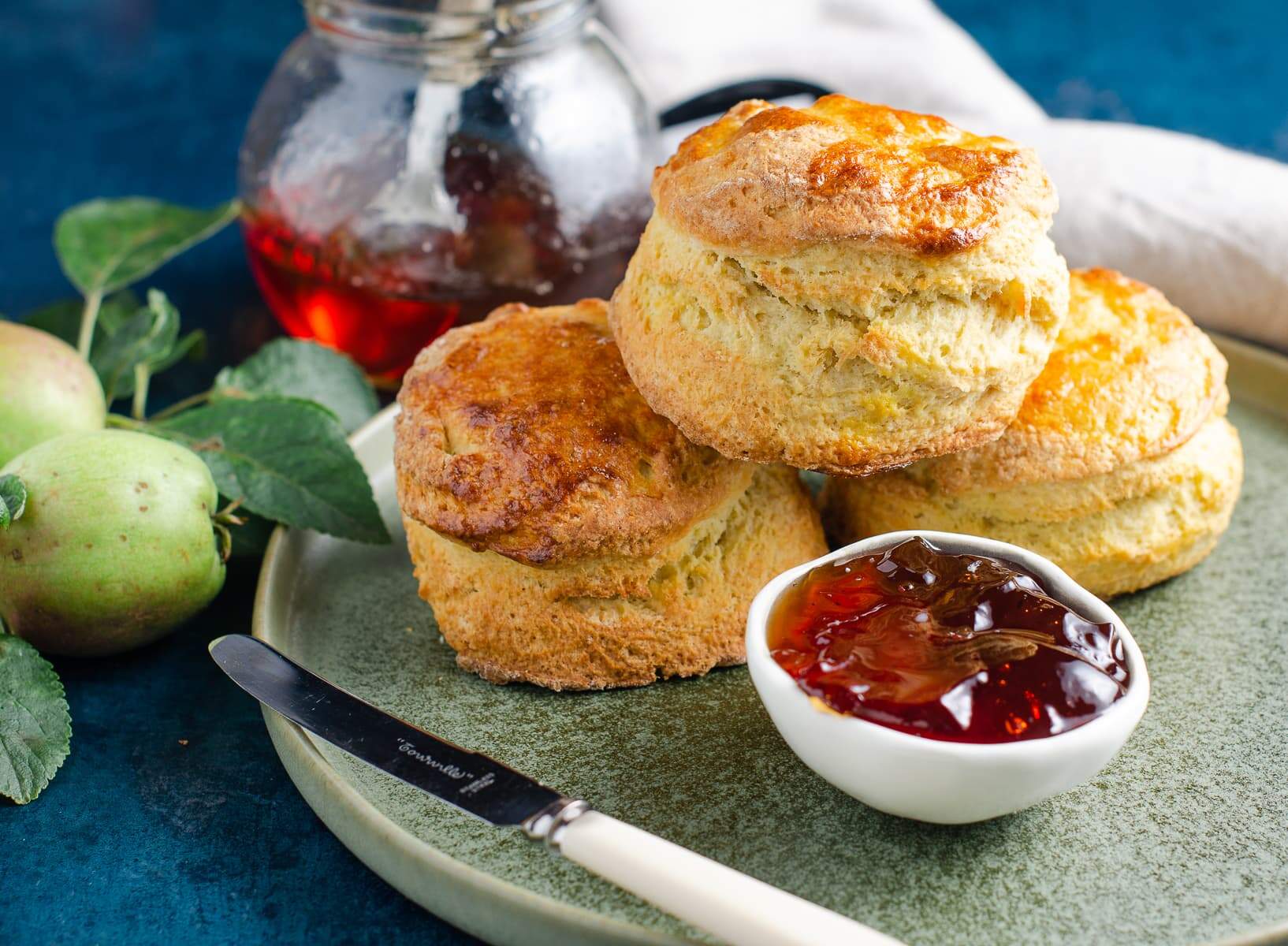
How long can I store homemade apple jelly?
Sealed and stored in a cool, dry cupboard this homemade apple jelly will store for 1 year.
Once a jar of jelly has been opened it should be stored in the refrigerator and used within a month.
Freezing the apple juice:
If you don't have time to strain the apples and then make the jelly, then separate out the two processes. The apple juice can be easily stored in the freezer, ready to make the jelly at a later date.
Other uses for apple jelly:
As well as enjoying apple jelly on some warm toast or freshly baked scones, I like to use apple jelly in savoury cooking.
Add a spoon of apple jelly to a sauce or gravy and you will elevate it. I always add apple jelly to my pork, chicken or turkey gravy. Likewise it always gets added to my Spiced Red Cabbage.
Serve apple jelly alongside pork or venison in place of a red currant jelly. This versatile jelly is also delicious served on a cheeseboard, heavenly with a creamy blue cheese!
Pin the recipe:
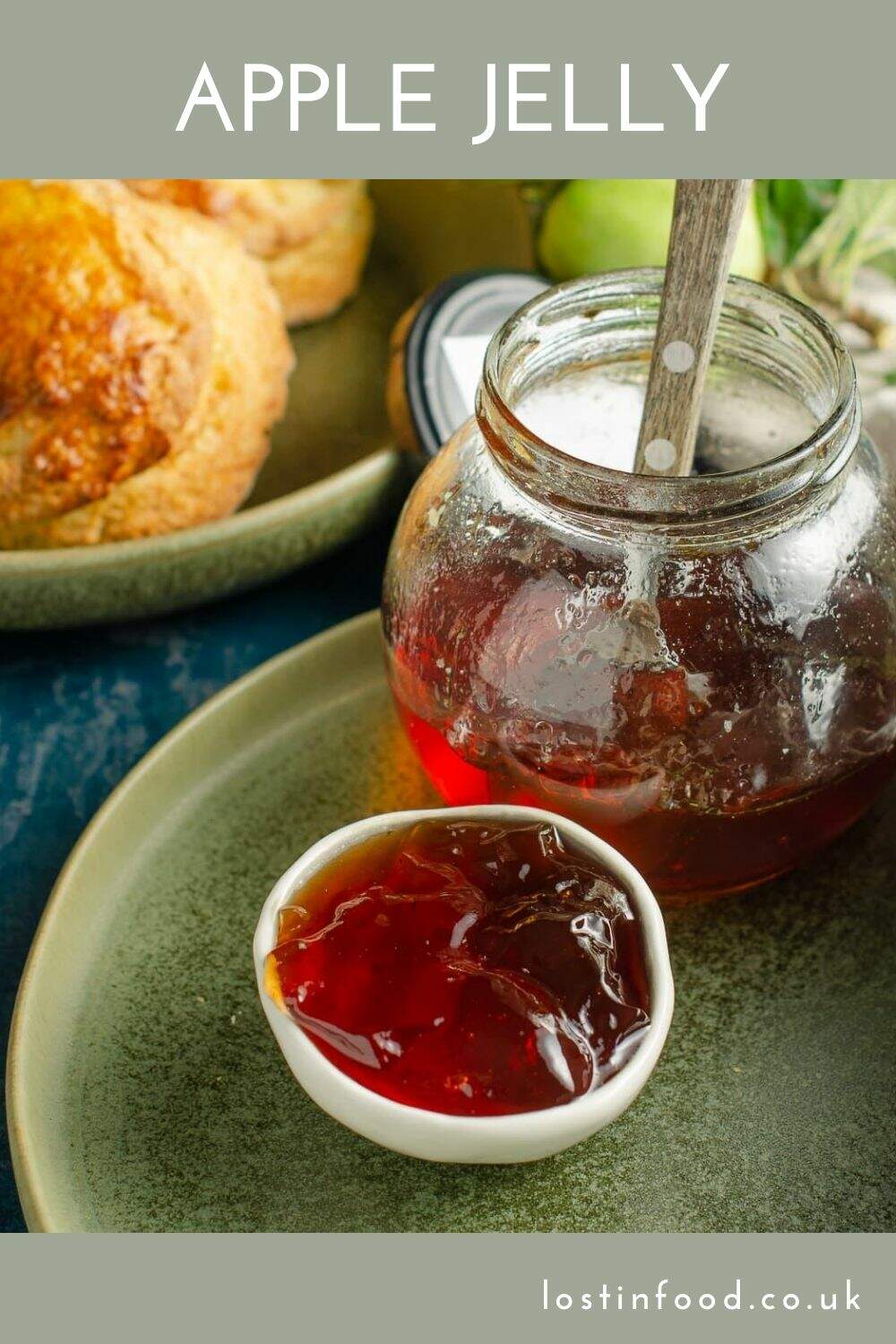
Additional recipe suggestions:
If you enjoy making jellies and jams, try some of our other recipes:
- Scottish Strawberry Jam
- Rhubarb & Ginger Jam
- Blackberry Jelly (Bramble Jelly)
- Scottish Raspberry Jam
- Blackcurrant Jelly
Why not spread some seedless apple jam on these tasty bakes:
For another great fruit preserve try our Spicy Sweet Chilli Jam or our Mulled Pears, both are great on a cheeseboard or with cold cuts.
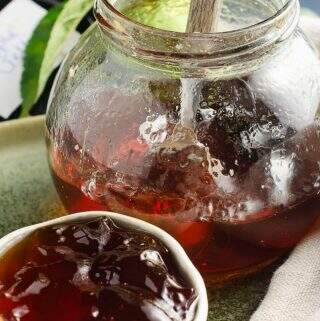
Apple Jelly
Equipment
- Large jam pan or stock pot
- Jelly bag
- Stand to drain fruit
- Sterlised jars
- Thermometer
- Jam funnel (optional)
- Wax paper discs (for setting on top of jelly)
Ingredients
To make apple juice
- 2.5 kg apples (quartered)
- 1.5 ltr water
To make apple jelly
- 1.2 ltr strained apple juice
- 900 g granulated sugar
Instructions
Set up equipment
- Before you start get your equipment ready and set up. You will need a jam pan or a large stock pot both to cook your apples and later to make your jelly.
- To make jelly you will require a jelly bag and a stand to hold the bag to allow you to drain the fruit. Set up your jelly bag and stand over the bowl that you are using to collect the strained liquid. (My Dad made my stand for me however, these are readily available online or from hardware stores).
Sterilise jars
- Sterilise your jars and lids (ensure lid is separate to jar). My preferred method is to put them through a cycle in my dishwasher, unloading them while still hot onto an ovenproof tray. Place them in an oven at 170C/150CFan until needed.
- Place a saucer in the freezer for testing the jelly later.
To make the apple juice
- Wash the apples and cut into quarters, no need to core or peel them (remove any rotten pieces). Place your fruit in a large saucepan and add water, which should come just below the top of the fruit.
- Bring to the boil and then reduce to a simmer and cook the fruit until it is soft and you can insert a knife easily into the apple. This will take between 30-45 minutes depending on the size of apples you are using.
- Take the pan off the heat and gently spoon the mixture into the jelly bag. Do not be tempted to press the fruit down into the bag, nor squeeze the bag, as this will give you a cloudy jelly. Leave the liquid to drain from the bag until it has finished dripping into the bowl below, then discard the fruit. This should take around 4 hours but can be left overnight. [Note: if making a mixed jelly repeat this process with the second fruit.)
Make the apple jelly
- Once drained pour the juice into a large, heavy based saucepan or stockpot. For every 600ml (1 pint) of fruit liquid you will need to add 450g (1lb) of granulated sugar to the pan. I use ordinary unrefined granulated sugar as jam sugar tends to be more expensive. [Jam sugar contains added pectin which I have never needed to use as the apples contain enough themselves. See further note on sugar in the recipe post.]
- Put the pan on the heat and bring to the boil before reducing the heat a little to get a good rolling boil. This is really important as a rolling boil is required to get the jelly to the right temperature for setting. Try not to stir the liquid as stirring will only reduce the temperature. As you are heating the liquid skim off an scum that may appear, whilst doing you no harm it doesn't look good once set. You want to achieve a nice clear jelly.
Testing the set of the jelly
- Here comes the difficult bit, knowing when to take the jelly off the heat. There are a number of tests, if using a jam thermometer the setting point for jelly is around 104.5C/220F. Use a jam thermometer to let you know when the jelly is ready.
- When ready to test the jelly take the pan off the heat until you test the set. This will stop the jelly from cooking too much while you test.
- It is then worth doing the wrinkle test. If you placed a plate in the freezer before you started making jelly, take it out when you think the jelly is almost ready. Spoon some jelly onto the cold plate, pop it back in the freezer for a minute or two, then take it back out and push the jelly with my finger to see if it wrinkles. If it does then the jelly is ready.
- If you want a really firm set the wrinkle will stay in place after you have removed your finger. [This is the most difficult part of the process and it is something that becomes easier over time as your begin to know what to look for. That said, I have potted jelly into jars only to return it to the pan the following day for a further boil as it was just too soft a set!]
- If you think the jelly is a little runny and loose, return the pan to the heat and get it back on a rolling boil for another 10 minutes and test again.
- Pot the jelly while it is still hot into the sterilised jars. Take care as the liquid is very hot, use a jam funnel over the top of the jars to get the jelly cleanly into the jars and avoid spillage. Next place a wax disc on top as it prevents the jelly drying out and also stops any mould from forming. Seal with a screw on lid and set aside to cool. Once cool label the jelly and store in a cool, dry place. The jelly should keep for at least year stored like this.
Notes
• Please note that the nutrition information provided above is approximate and meant as a guideline only •

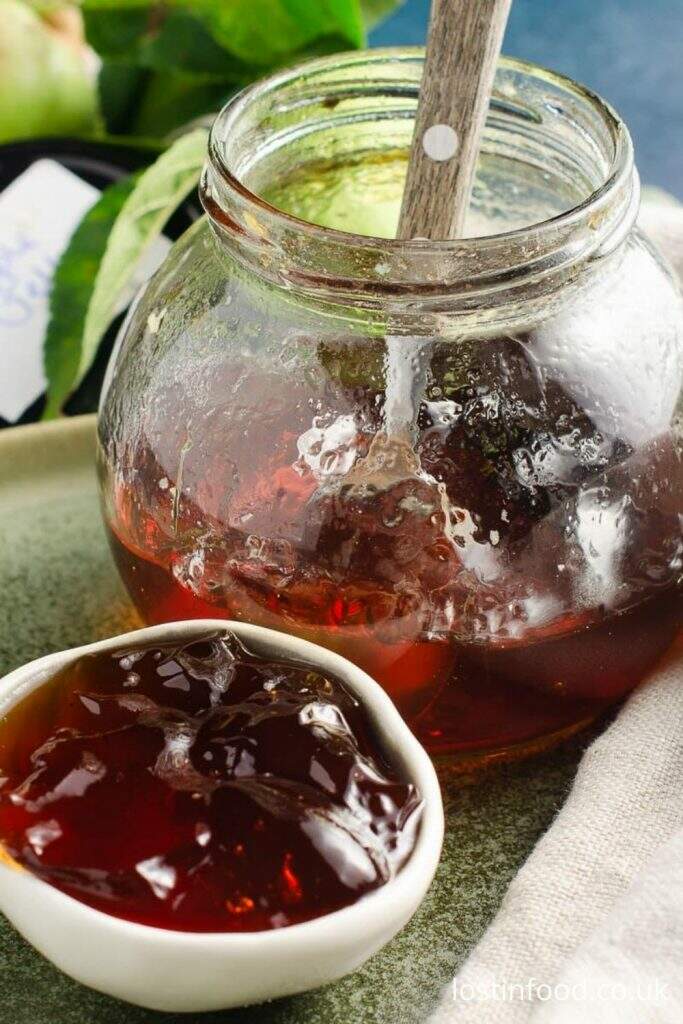
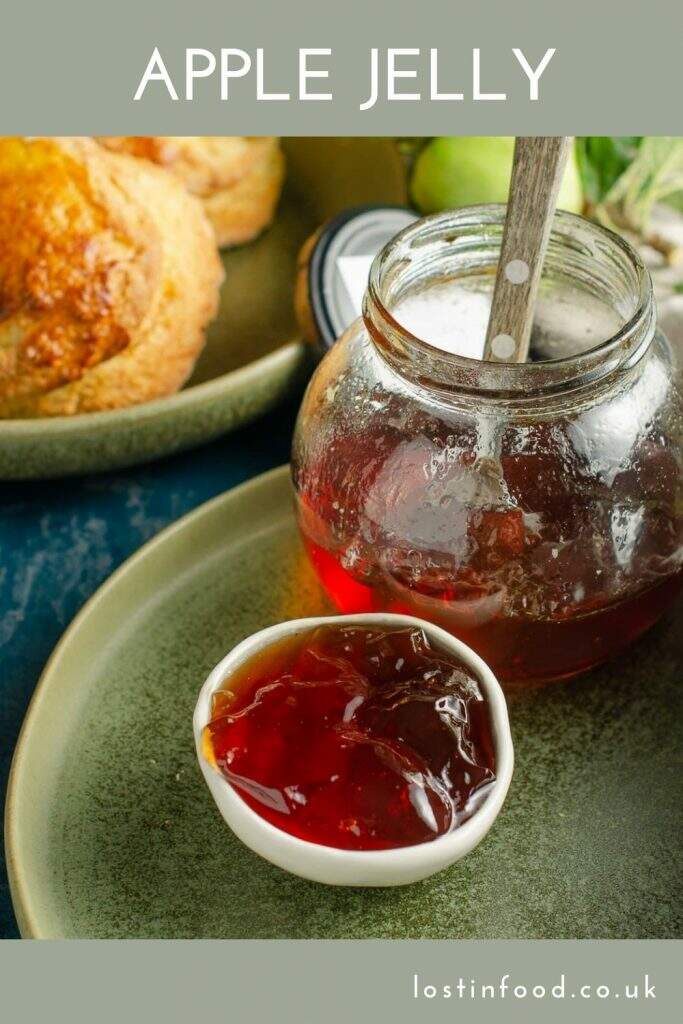
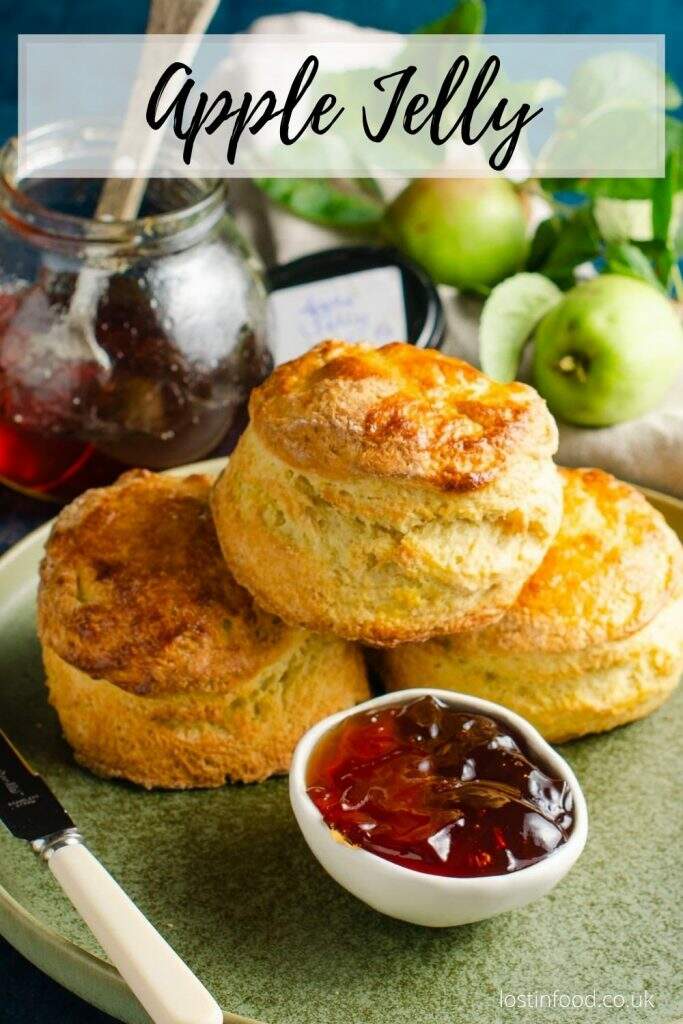
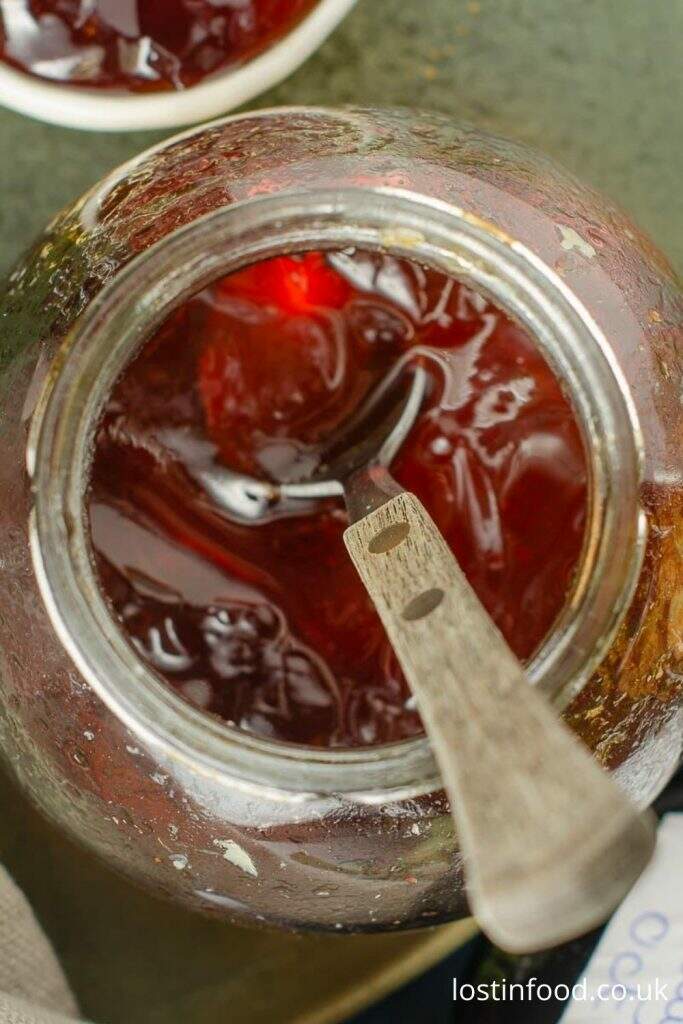
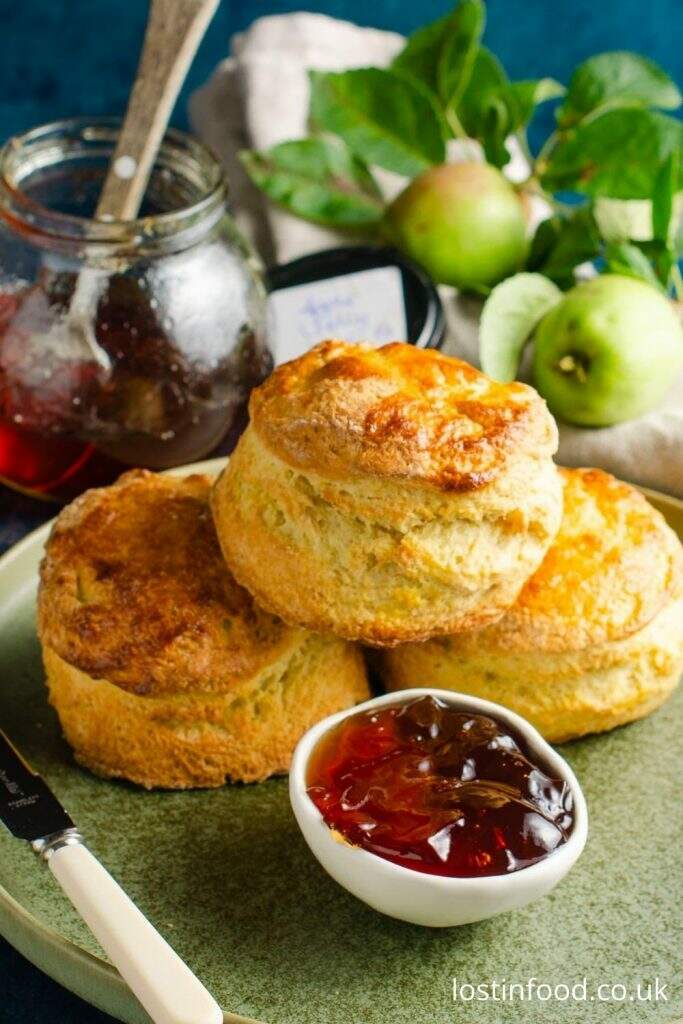
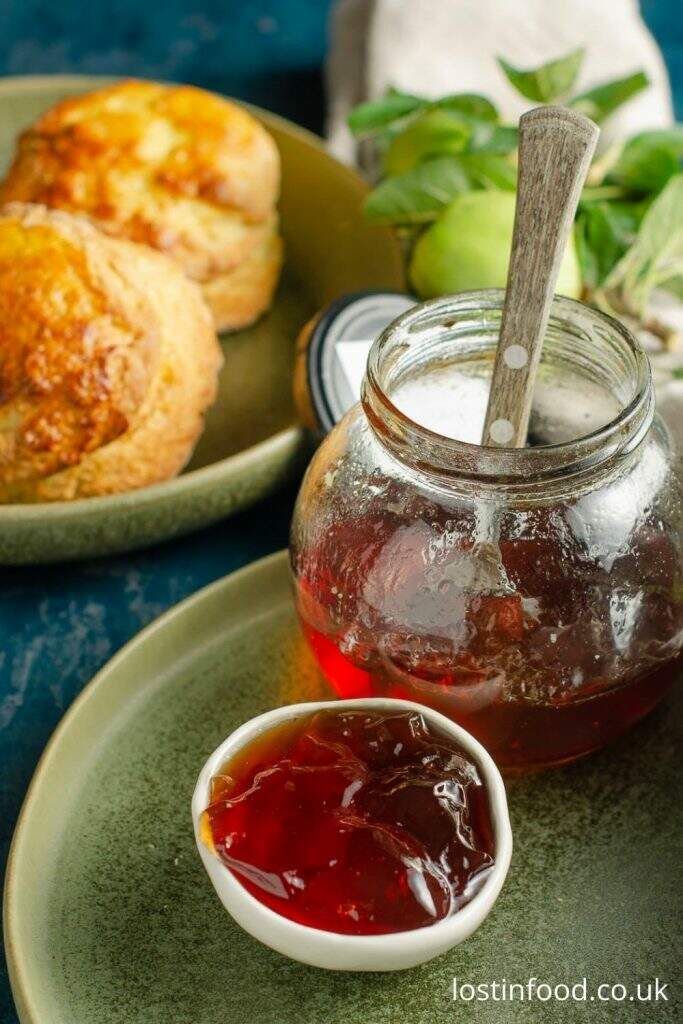
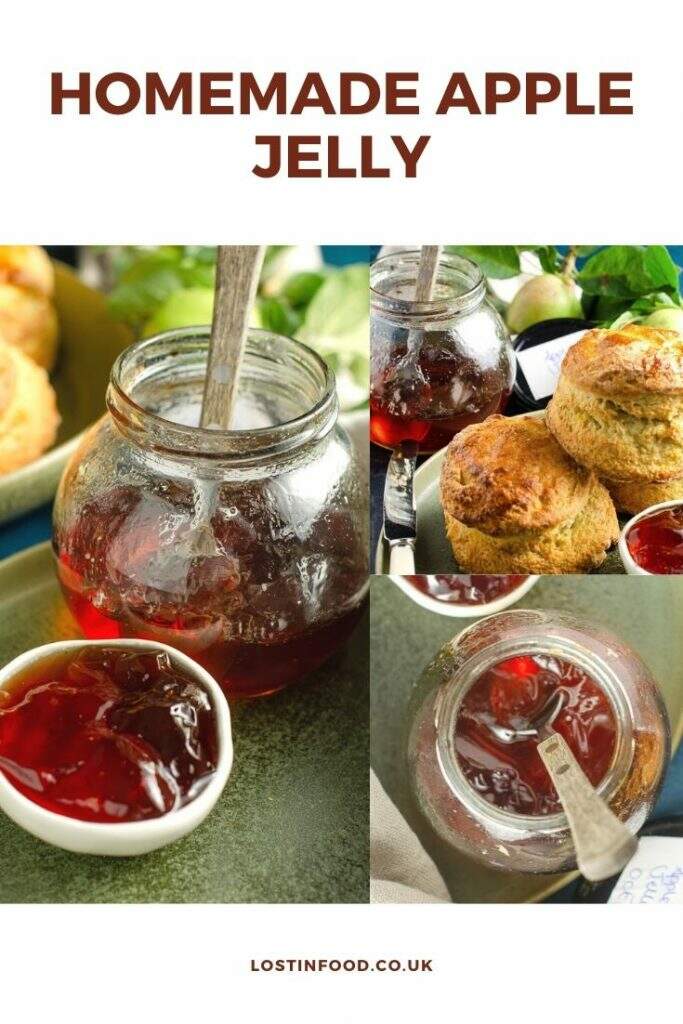
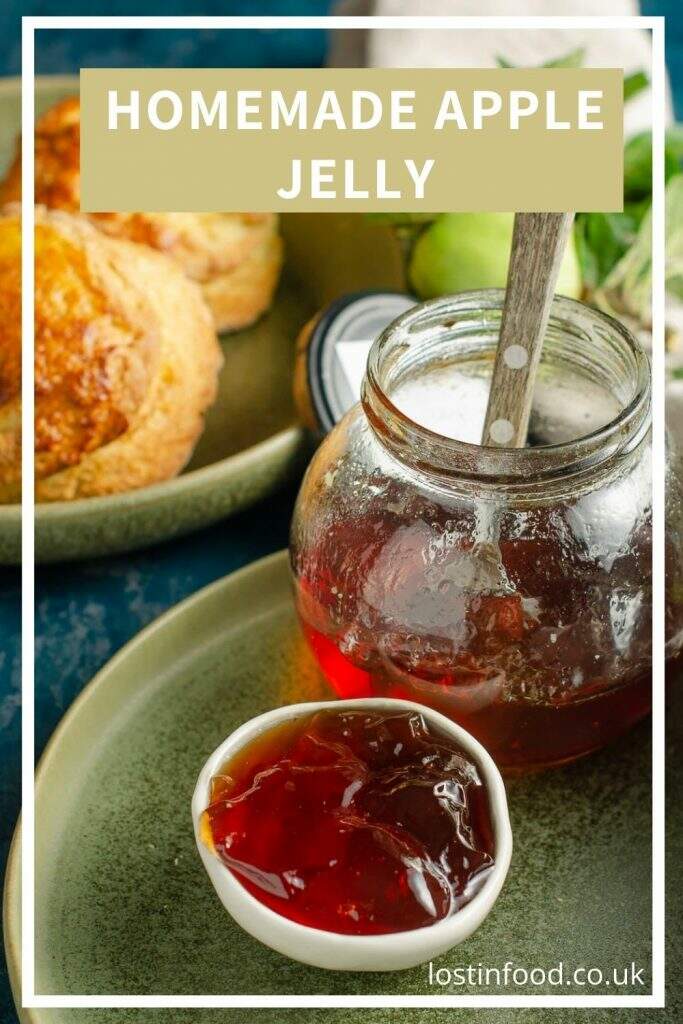
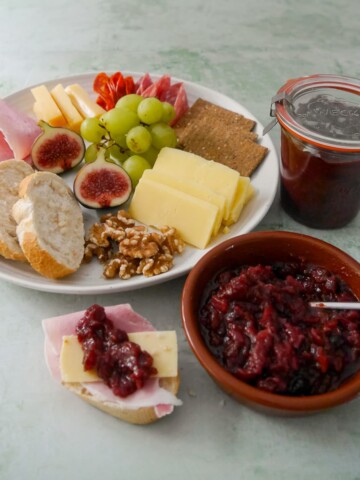
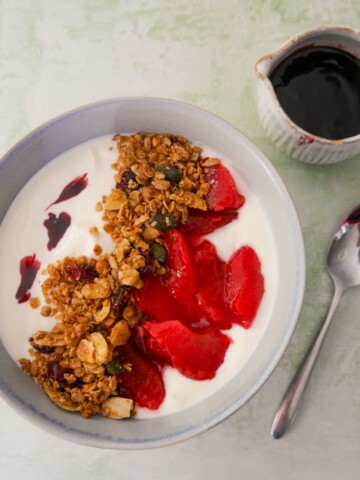

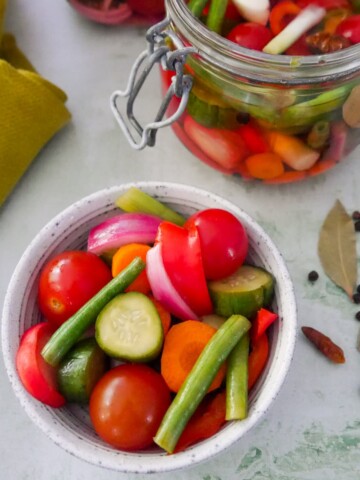
Jane says
This is my go to recipe for apple jelly. Every autumn when we harvest the apples from our garden (a mixture of red and green eating varieties - not sure which exactly) and it supplies us with enough jelly to see ourselves through a whole year (we enjoy it on toast with peanut butter) plus extra to give as Xmas presents.
Lesley says
Thank you Jane, I'm really happy to hear that. This recipe has served me well over the years and like you I often make it with a variety of apples. My friend has the most glorious tree of red apples with red flesh on the inside, which makes the most glorious coloured jelly. On toast with peanut butter is about as close to perfect as it gets for me too. I also use it when I'm making savoury sauces and gravies, as it balances out the flavour.